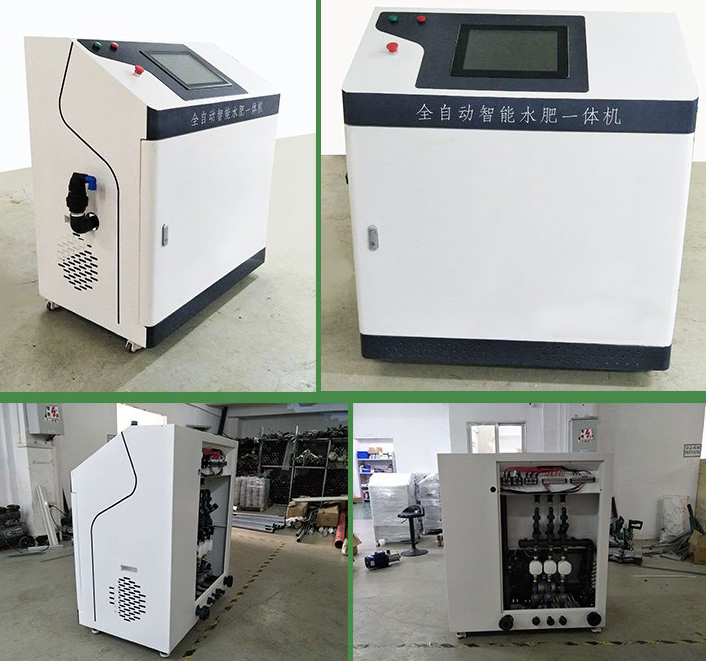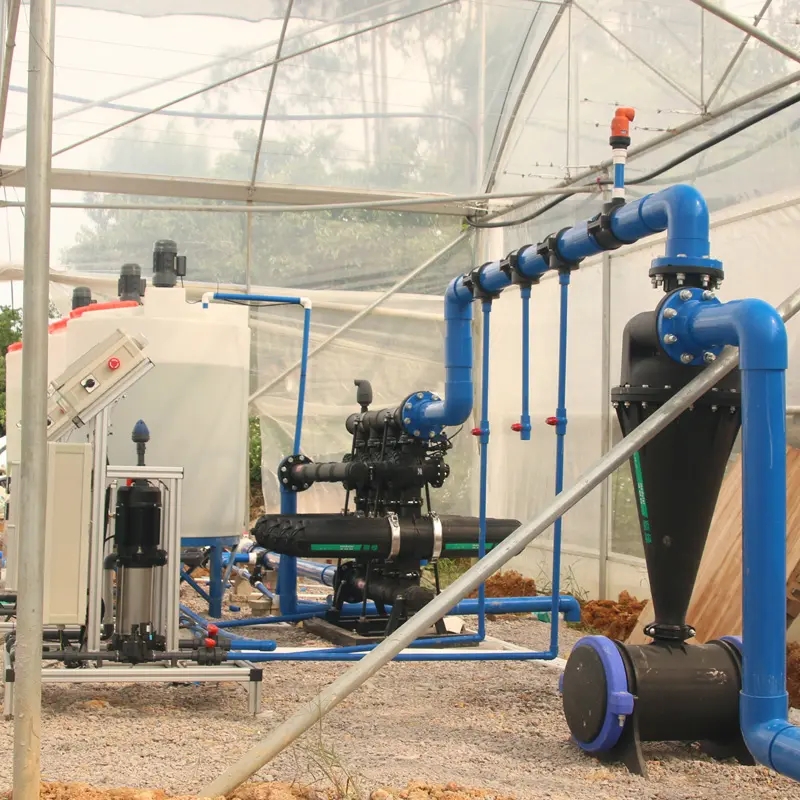

— Blogs —
—Products—
 Consumer hotline +8618073152920
Consumer hotline +8618073152920 WhatsApp:+8615367865107
Address:Room 102, District D, Houhu Industrial Park, Yuelu District, Changsha City, Hunan Province, China
Product knowledge
Time:2025-11-27 15:40:06 Popularity:15
Modern agriculture is embracing the wave of intelligence and precision. The NiuBoL Water-Fertilizer Integration Intelligent Irrigation System integrates smart control, precise monitoring, and efficient management functions, providing a revolutionary irrigation and fertilization solution for farmland. Through IoT technology, soil sensors, and weather monitoring, the system achieves precise water and fertilizer regulation, improves water use efficiency, reduces labor intensity, enhances crop yield and quality, and provides technical support for sustainable agricultural development.

The NiuBoL system is a comprehensive solution that combines intelligent irrigation with precise fertilization. Its core principle is a closed-loop “Soil-Water-Fertilizer” control system:
1. Soil sensor monitoring: Uses FDR (Frequency Domain Reflectometry) to measure soil moisture and electrical conductivity (EC), reflecting real-time soil water and nutrient status.
2. Weather data assistance: Weather stations monitor temperature, humidity, rainfall, wind speed, and light intensity to dynamically adjust irrigation plans.
3. Water-fertilizer machine regulation: Automatically adjusts fertilizer concentration and irrigation volume based on soil and weather data for precise supply.
4. Automatic valves and pipeline network execution: Intelligent valves control irrigation in different zones for partitioned precision irrigation.

The NiuBoL intelligent irrigation system consists of seven major modules:
The core of the system, featuring data analysis, remote control, and automated management.
Supports mobile and PC monitoring, historical data viewing, alarm notifications, and irrigation strategy management.
Real-time monitoring of source water pH, EC, and harmful substances to ensure safe irrigation water quality.
Multi-stage filtration removes particles, impurities, and microorganisms, protecting the system from clogging and corrosion and extending equipment lifespan.

Automatically mixes fertilizer with water and precisely controls fertilizer ratios, improving utilization rates and reducing waste.
Forms a flexible and efficient irrigation network with precise control over irrigation range and volume. Linked with sensors for fully automatic irrigation.
Uses NBL-S-THR or NBL-S-TM soil temperature, humidity, and EC sensors to provide accurate data for irrigation and fertilization decisions.
Monitors ambient temperature, humidity, light intensity, wind speed, etc., to optimize irrigation and fertilization plans.
- Soil moisture: FDR method measures soil dielectric constant — fast, accurate, unaffected by fertilizer or metal ions.
- Soil temperature: Thermistor measurement, resolution 0.1°C, accuracy ±0.5°C.
- Soil nutrient concentration: Measured via EC value, combined with crop water and fertilizer demand calculations.
- Weather monitoring: Real-time data collection and upload of temperature, humidity, wind speed, light, rainfall, etc.
1. Soil sensors: 2–6 sensors per monitoring zone depending on crop type and field size; burial depth matches main root zone.
2. Pipeline layout: Pipe diameter selected according to flow rate; valves installed on main branches with flushing ports reserved.
3. Water-fertilizer machine: Installed on a clean, level base, connected to water source and fertilizer tanks, ensuring waterproofing and smooth ventilation.
4. Weather station: Placed in an open, well-ventilated area without shading for accurate sensor performance.
5. Power and network: Supports mains or solar power; full network coverage required for remote monitoring.
1. Abnormal soil sensor data → Check probe-soil contact and clean contaminants.
2. No water/fertilizer output → Check inlet pipeline and filter blockage.
3. Valve fails to open → Check power, control signal, and solenoid coil.
4. Software cannot connect → Verify network and IP configuration.
5. Insufficient irrigation volume → Check for pipeline leaks or low pump pressure.
6. Abnormal water quality readings → Recalibrate sensor or check source contamination.
7. Frequent alarms → Verify reasonable parameter thresholds.
8. Data transmission delay → Inspect cables, communication protocol, and network stability.
9. Short sensor lifespan → Avoid mechanical damage and chemical corrosion.
10. Automatic irrigation not starting → Confirm sensor data and strategy settings.

1. Arid and water-scarce regions: Precise irrigation maximizes water efficiency.
2. High-value crops (vegetables, fruits, flowers): Precise fertilization improves yield and quality.
3. Intelligent greenhouses: Closed environment with precise control of temperature, humidity, light, water, and fertilizer.
4. Large farms and agricultural cooperatives: Remote monitoring and automation reduce labor costs and support large-scale production.
5. Scientific research and experiments: Long-term soil and fertilizer data for crop growth studies and irrigation strategy optimization.
- Small farms: Basic sensor + water-fertilizer machine package.
- High-value crops or research: High-precision multi-point soil monitoring with remote management and automatic alarms.
- Remote areas: Solar power + backup battery configuration.

Supports sandy, loamy, clay, and all common soil types. FDR sensors measure true moisture via dielectric constant, unaffected by soil texture or fertilizers.
Intelligent control automatically calculates required ratios based on soil moisture, crop demand, and irrigation strategy, achieving >95% fertilizer utilization.
Yes, full remote monitoring via PC and mobile apps — real-time soil, weather, water quality, and irrigation status viewing, plus remote start/stop/adjustment.
NBL-S-THR and NBL-S-TM sensors are IP68 rated, fully waterproof, acid/alkali resistant, suitable for long-term burial.
Designed for -40°C to +85°C, with high/low temperature protection, rain/snow protection, and anti-corrosion measures.

Fully scalable — multiple sensors can be deployed for refined zone-specific control.
Yes, complete solar + battery solutions available for off-grid areas.
All data exportable in Excel/CSV format for scientific analysis.
Very low — long-life sensors, durable pipes/valves, only periodic filter cleaning required. Overall cost far below traditional methods.
10. Does it support remote alarms and automatic control?
Yes — automatic alarms via SMS/app and fully automatic irrigation start/stop based on preset rules.

Through advanced sensors, IoT, and intelligent control technology, the NiuBoL Water-Fertilizer Integration Intelligent Irrigation System achieves precise water and fertilizer regulation, real-time monitoring, and remote management. It significantly improves irrigation efficiency, crop yield, and quality while saving water and fertilizer resources and reducing labor costs. Applicable to open fields, greenhouses, orchards, and scientific research, combined with comprehensive troubleshooting, selection guidance, and data analysis functions, NiuBoL provides a complete technical solution for modern, intelligent, green, and sustainable agriculture.
Prev:Rainfall Weather Station & Rainfall Sensor: Key Equipment for Precise Precipitation Monitoring
Next:no more
Related recommendations
Sensors & Weather Stations Catalog
Agriculture Sensors and Weather Stations Catalog-NiuBoL.pdf
Weather Stations Catalog-NiuBoL.pdf
Related products
 Combined air temperature and relative humidity sensor
Combined air temperature and relative humidity sensor Soil Moisture Temperature sensor for irrigation
Soil Moisture Temperature sensor for irrigation Soil pH sensor RS485 soil Testing instrument soil ph meter for agriculture
Soil pH sensor RS485 soil Testing instrument soil ph meter for agriculture Wind Speed sensor Output Modbus/RS485/Analog/0-5V/4-20mA
Wind Speed sensor Output Modbus/RS485/Analog/0-5V/4-20mA Tipping bucket rain gauge for weather monitoring auto rainfall sensor RS485/Outdoor/stainless steel
Tipping bucket rain gauge for weather monitoring auto rainfall sensor RS485/Outdoor/stainless steel Pyranometer Solar Radiation Sensor 4-20mA/RS485
Pyranometer Solar Radiation Sensor 4-20mA/RS485
Screenshot, WhatsApp to identify the QR code
WhatsApp number:+8615367865107
(Click on WhatsApp to copy and add friends)
